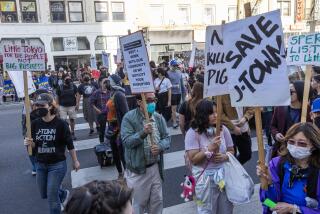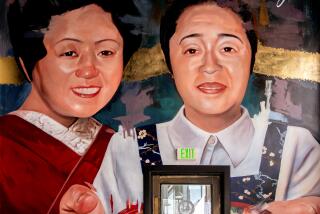Tokyo’s Shinjuku Station Churns Through 1.3 Million Passengers a Day
TOKYO — They once hired college students to help shove commuters into the packed cars at Tokyo’s Shinjuku Station, easily the world’s busiest passenger train hub. Now regular employees do the cramming.
“We have five rush hours every day,” says Masahiro Kato of the Shinjuku Stationmaster’s Office.
Traffic is so heavy, Kato says, the metal hand punches used to punch tickets wear out and must be replaced every three days. Railway workers must clean up about 300,000 cigarette butts every day.
And the bustling complex in the high-rise, low-life environs of Shinjuku is getting busier, with new rail lines linking the suburbs and the city government planning to abandon its buildings near the Imperial Palace for a new home near the station.
1.3 Million People
Every day, according to officials, an average of 1.3 million people are disgorged from or swept into the 1,800 commuter, subway and long-distance trains passing through this business and entertainment center in western Tokyo.
That is more than twice as many as any other rail station outside Japan. By comparison, 500,000 people a day pass through New York’s two main stations, Penn and Grand Central, a similar number at Moscow’s Yaroslavsky station, and 420,000 at Paris’ St. Lazare station. (The latter figure does not include subway riders).
In fact, Shinjuku’s nearest rival is Ueno Station, the northern gateway to this city of 12 million, which handles about 870,000 travelers per day.
The first rush hour begins around 4:30 a.m., when the station opens and red-eyed carousers who missed the last night train begin making their way home or back to the office. Shinjuku has thousands of drinking and eating establishments. It is home to an infamous red-light district of massage parlors, peep shows and love hotels, and is a principal center for Tokyo’s gay nightlife.
Sea of Commuters
About 8 a.m., the sea of commuters descends on Shinjuku, some headed for the cluster of 50-story office skyscrapers just west of the station, others changing to subways or the 29-stop Yamanote line, a surface railroad that makes a loop around the city.
Kato says Shinjuku station, which is operated by Japan National Railways, used to hire college students part time to pack people into rush-hour trains. But the morning chaos has eased some in recent years because of new lines and now Shinjuku’s 413 employees do the pushing, Kato says.
Between 10 a.m. and 11 a.m. comes the next wave--housewives and young people heading for the department stores, boutiques and discount electronics shops that surround the station.
The reverse flows come at 6 p.m. to 7 p.m., the big homebound rush, and 12 a.m. to 1 a.m. when barhoppers dash for the last trains home.
Railway, Subway Lines
In addition to Japan National Railways’ 12 platforms for commuter, intercity and long-distance lines to western and northern Japan, Shinjuku is the hub for two subway lines and three private commuter lines.
The “Alps Plaza,” at the entrance to platforms for lines to the central Japan mountains, is thronged on weekends by thousands of young people in designer ski gear, Tyrolean mountaineering garb and Little League baseball uniforms.
Color-coded signs are a help, but even some longtime residents of Tokyo, particularly foreigners, say they have never fully mastered the station’s bewildering, multistory maze of corridors, stairways, escalators, shops, department stores, ticket offices and rail platforms.
Crime and vandalism are rare on Japanese trains, but Ichiro Watanabe, assistant chief of station security, says his office handled 704 cases of picked pockets last year, making 76 arrests.
Drunks a Problem
More time is spent looking after the thousands of drunks who fall asleep or forget where they live.
“We let them dry out for an hour or call their wives to come pick them up,” Watanabe says. Traditional tolerance toward drinking makes Japan “heaven for drunks,” he adds.
Before the station closes down at night, the security force of 65 also herds out the several dozen hobos who camp in corridors during the day. They are also constantly alert for runaways who flock to Shinjuku and become prey for the more sinister elements of its nightlife district.
Shinjuku--it means “new lodging”--was one of four “post-station” towns on the outskirts of Tokyo, called Edo in Japan’s feudal period, where city borders were guarded and travelers could pause overnight before continuing into the wilderness beyond. Later it became a quiet farming village, until 1925 when the loopline opened and the expanding city swallowed it up.
Expansion Includes Hotels
In recent years, several luxury hotels, including the new Tokyo Hilton, have sprung up in west Shinjuku.
Last year, Tokyo Gov. Shuichi Suzuki pushed through legislation to move Tokyo’s government from Marunouchi, near the fashionable Ginza and the moated Imperial Palace, to the same area.
The plan calls for two 50-story government office buildings to be completed by 1990 at a cost of $1.7 billion in west Shinjuku, about 3 1/2 miles from the city center.
The station added a new national railways suburban line in March, and Shinjuku will get another subway line in the 1990s. But Kato says that with the influx of government workers, “things can only get more crowded.”
More to Read
Sign up for Essential California
The most important California stories and recommendations in your inbox every morning.
You may occasionally receive promotional content from the Los Angeles Times.










